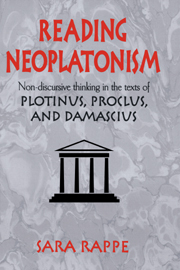Book contents
- Frontmatter
- Contents
- Preface: Discursive Strategies and Neoplatonic Texts
- Acknowledgments
- List of Abbreviations
- 1 Introduction. Representing a Tradition: Exegesis, Symbol, and Self-reflection
- PART I LANGUAGE IN THE ENNEADS
- PART TWO TEXT AND TRADITION IN NEOPLATONISM
- 6 History of an Enigma: Mathematical Symbolism in the Neoplatonic Tradition
- 7 Transmigrations of a Myth: Orphic Texts and Platonic Contexts
- 8 Language and Theurgy in Proclus' Platonic Theology
- 9 Damascius' Ineffable Discourse
- 10 Conclusion: Reading Neoplatonism
- References
- General Index
- Index Locorum
10 - Conclusion: Reading Neoplatonism
Published online by Cambridge University Press: 24 October 2009
- Frontmatter
- Contents
- Preface: Discursive Strategies and Neoplatonic Texts
- Acknowledgments
- List of Abbreviations
- 1 Introduction. Representing a Tradition: Exegesis, Symbol, and Self-reflection
- PART I LANGUAGE IN THE ENNEADS
- PART TWO TEXT AND TRADITION IN NEOPLATONISM
- 6 History of an Enigma: Mathematical Symbolism in the Neoplatonic Tradition
- 7 Transmigrations of a Myth: Orphic Texts and Platonic Contexts
- 8 Language and Theurgy in Proclus' Platonic Theology
- 9 Damascius' Ineffable Discourse
- 10 Conclusion: Reading Neoplatonism
- References
- General Index
- Index Locorum
Summary
Throughout this book, I have been talking about the “Neoplatonic tradition” as if this phrase referred to a well-defined phenomenon such as a group of philosophers who, in company with each other, formulated a self-consistent set of doctrines. Yet it is not just the complexity of Neoplatonic scholasticism, particularly its subtle integration of Aristotelianism, Stoicism, and Platonism, nor the major shifts in its philosophical vocabulary, such as the influence of Iamblichean theurgy precipitated, that makes it so difficult to locate the factors promoting the continuity of the school. Although the broad outlines of what we today might call a philosophical system can be seen in many of the philosophers who today fall under this sobriquet, the fact remains that the Neoplatonists themselves traced their philosophical genealogy in strikingly different ways. A time span of three centuries makes an unbroken succession of teachers and students an unlikely way to account for the cohesiveness of the tradition.
I have ended this book with the work of Damascius, the last Platonic Successor. Despite his official ties to the ancient Platonic school, his own membership in the tradition is anything but straight-forward. In the midst of the upheaval, persecution, and ideological pressures exerted on him, with a millenium separating him from classical Athens, Damascius seemingly had to rediscover or renew the tradition whose last proponent he became.
- Type
- Chapter
- Information
- Reading NeoplatonismNon-discursive Thinking in the Texts of Plotinus, Proclus, and Damascius, pp. 231 - 244Publisher: Cambridge University PressPrint publication year: 2000



